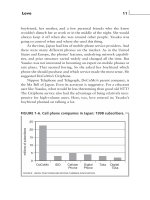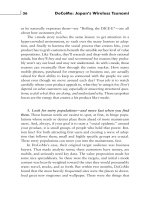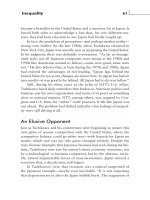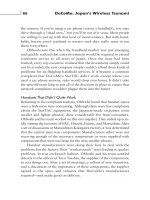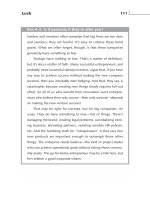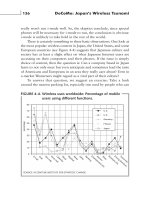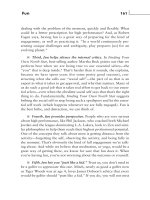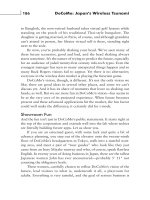International financial market and korean economy global macroeconomic environments
Bạn đang xem bản rút gọn của tài liệu. Xem và tải ngay bản đầy đủ của tài liệu tại đây (371.85 KB, 32 trang )
International Financial Market
and Korean Economy
Class 1 Global Macroeconomic Environments
(FT CH.12)
Introduction
Microeconomics Vs. Macroeconomics
International Economics Vs. International Finance
International Trade Vs. International Macroeconomics
Finance Vs. International Finance
International Finance is an area of macroeconomics focusing
on assessing the relative performance of an economy as a
whole in connection with other economies.
Trades of Currencies FX
It focuses on key economy-wide variables such as exchange
rates, prices, interest rates, income, wealth, and the current
account.
1 Foreign Exchange: Currencies and Crises
A complete understanding of how a country’s economy
works requires that we study the exchange rate, the price of
foreign currency.
Because products and investments move across borders,
fluctuations in exchange rates have significant effects on the
relative prices of home and foreign goods (such as autos and
clothing), services (such as insurance and tourism), and
assets (such as equities and bonds).
How Exchange Rates Behave
• Based on observable differences in exchange
rate behavior, economists divide the world
into two groups of countries: those with fixed
(or pegged) exchange rates and those with
floating (or flexible) exchange rates.
Key Topics
• How are exchange rates determined?
• Why do some exchange rates fluctuate sharply in the short
run, while others are almost constant?
• What explains why exchange rates rise, fall, or stay flat in the
long run?
Why Exchange Rates Matter
Changes in exchange rates affect an economy in two ways:
■ Changes in exchange rates cause a change in the international
relative prices of goods. That is, one country’s goods and
services become more or less expensive relative to another’s
when expressed in a common unit of currency.
■ Changes in exchange rates can cause a change in the
international relative prices of assets. These fluctuations in
wealth can then affect firms, governments, and individuals.
Why Exchange Rates Matter
Key Topics
• How do exchange rates affect the real economy?
• How do changes in exchange rates affect international prices,
the demand for goods from different countries, and hence the
levels of national output?
• How do changes in exchange rates affect the values of foreign
assets, and hence change national wealth?
When Exchange Rates Misbehave
• In an exchange rate crisis a currency experiences a sudden
and pronounced loss of value against another currency
following a period in which the exchange rate had been fixed
or relatively stable.
FIGURE 12-2
Currency Crashes The
chart shows that exchange
rate crises are common
events.
When Exchange Rates Misbehave
• Governments in crisis may appeal for external help from
international development organizations, such as the
International Monetary Fund (IMF) or World Bank, or other
countries.
Key Topics
• Why do exchange rate crises occur? Are they an inevitable
consequence of deeper fundamental problems in an economy
or are they an avoidable result of “animal spirits”—irrational
forces in financial markets?
• Why are these crises so economically and politically costly?
• What steps might be taken to prevent crises, and at what cost?
2 Globalization of Finance: Debts and Deficits
Deficits and Surpluses: The Balance of Payments
• Financial globalization has taken hold around the world,
starting in the economically advanced countries and spreading
to many emerging market countries.
• At the national level, economic measurements such as
income, expenditure, deficit, and surplus, are important
barometers of economic performance, and the subject of
heated policy debate.
• The income measure is called gross national disposable
income; the expenditure measure is called gross national
expenditure. The difference between the two is a key
macroeconomic aggregate called the current account.
Deficits and Surpluses: The Balance of Payments
TABLE 12-1 (1 of 2)
Inflation Performance and the Exchange Rate Regime
The table shows data for the United States from 1990 to 2009 in billions of U.S. dollars. During
this period, in all but one year U.S. expenditure exceeded income, with the U.S. current account
in deficit. The last (small) surplus was in 1991.
Deficits and Surpluses: The Balance of Payments
TABLE 12-1 (2 of 2)
Inflation Performance and the Exchange Rate Regime (continued)
The table shows data for the United States from 1990 to 2009 in billions of U.S. dollars. During
this period, in all but one year U.S. expenditure exceeded income, with the U.S. current account
in deficit. The last (small) surplus was in 1991.
FIGURE 12-3
Global Imbalances Recently, the
United States’s current account
deficit has accounted for over half
of all deficits globally. Major
offsetting surpluses have been seen
in Asia (e.g., China and Japan) and
in oil-exporting countries.
Deficits and Surpluses: The Balance of Payments
Key Topics
• How do different international economic transactions contribute to
current account imbalances?
• How are these imbalances financed? How long can they persist?
• Why are some countries in surplus and others in deficit? What role
do current account imbalances perform in a well-functioning
economy?
• Why are these imbalances the focus of so much policy debate?
Debtors and Creditors: External Wealth
• Your total wealth or net worth is equal to your assets (what others
owe you) minus your liabilities (what you owe others).
• When you run a surplus, and save money (buying assets or paying
down debt), your total wealth, or net worth, tends to rise.
• Similarly, when you have a deficit and borrow (taking on debt or
running down savings), your wealth tends to fall.
• From an international perspective, a country’s net worth is called its
external wealth and it equals the difference between its foreign
assets (what it is owed by the rest of the world) and its foreign
liabilities (what it owes to the rest of the world).
• Positive external wealth makes a country a creditor nation (other
nations owe it money); negative external wealth makes it a debtor
nation (it owes other nations money).
Debtors and Creditors: External Wealth
FIGURE 12-4
External Wealth A country’s net credit position with the rest of the world is called external
wealth. The time series charts show levels of external wealth from 1980 to 2007 for the United
States in panel (a) and Argentina in panel (b). All else equal, deficits cause external wealth to
fall; surpluses (and defaults) cause it to rise.
Debtors and Creditors: External Wealth
Key Topics
• What forms can a nation’s external wealth take and does the
composition of wealth matter?
• What explains the level of a nation’s external wealth and how does
it change over time?
• How important is the current account as a determinant of external
wealth? How does it relate to the country’s present and future
economic welfare?
Darlings and Deadbeats: Defaults and Other Risks
• Sovereign governments can repudiate debt without legal
penalty or hurt creditors in other ways such as by taking away
their assets or changing laws or regulations after investments
have already been made.
• The difference between the interest paid on a safe
“benchmark” U.S. Treasury bond and the interest paid by on a
bond issued by a nation associated with greater risk is called
country risk.
• On June 21, 2010, the Financial Times reported that relatively
good investment-grade governments such as Poland (grade A−)
carried a country risk of +1.88%, governments with junk-bond
grades such as Colombia (grade BB+) had a country risk of
2.64%.
Darlings and Deadbeats: Defaults and Other Risks
Key Topics
• Why do countries default? And what happens when they do?
• What are the determinants of risk premiums?
• How do risk premiums affect macroeconomic outcomes such
as output and exchange rates?
3 Government and Institutions: Policies and Performance
• Government actions influence economic outcomes in many
ways by making decisions about exchange rates,
macroeconomic policies, whether to pay (or not pay) their
debts, and so on.
• To gain a deeper understanding of the global macroeconomy,
economists study policies, and also consider the broader
context or rules and norms, or regimes in which policy
choices are made.
• At the broadest level, research also focuses on institutions, a
term that refers to the overall legal, political, cultural, and
social structures that influence economic and political actions.
3 Government and Institutions: Policies and Performance
Three important features of the broad macroeconomic
environment that will play an important role in the remainder of
this book are:
1. The rules that a government decides to apply to restrict or
allow capital mobility.
2. The decision that a government makes between a fixed and
a floating exchange rate regime.
3. The institutional foundations of economic performance,
such as the quality of governance that prevails in a country.
Integration and Capital Controls: The Regulation of International
Finance
International trade has grown as trade barriers have been slowly
dismantled, and many nations have encouraged international capital
movement by lifting restrictions on financial transactions.
Three groups of countries that will figure often in our analysis are:
■ Advanced countries—countries with high levels of income per
person that are well integrated into the global economy
■ Emerging markets—mainly middle-income countries that are
growing and becoming more integrated into the global economy
■ Developing countries—mainly low-income countries that are not
yet well integrated into the global economy
Integration and Capital Controls: The Regulation of International
Finance
FIGURE 12-5
Financial Globalization Since the 1970s, many restrictions on international financial transactions
have been lifted, as shown by the time series chart in panel (a).
The volume of transactions has also increased dramatically, as shown in panel (b). These trends
have been strongest in the advanced countries, followed by the emerging markets and the
developing countries.
Integration and Capital Controls: The Regulation of International
Finance
Key Topics
Why have so many countries made the choice to pursue
policies of financial openness?
What are the potential economic benefits of removing capital
controls and adopting such liberalization policies?
If there are benefits, why has this policy change been so slow to
occur since the 1970s?
Are there any potential costs that offset the benefits? If so, can
capital controls benefit the country that imposes them?
Independence and Monetary Policy: The Choice of
Exchange Rate Regimes
FIGURE 12-6
Exchange Rate Regimes
The pie chart shows a
classification of exchange
rate regimes around the
world using the most
recent data for the year
2008.


